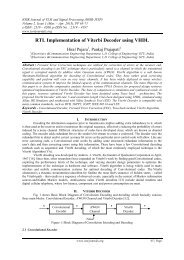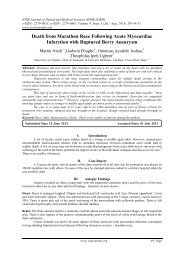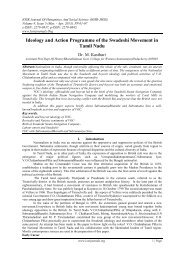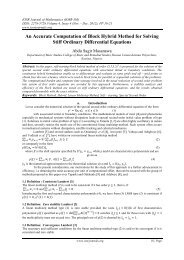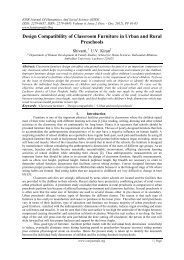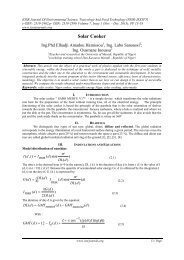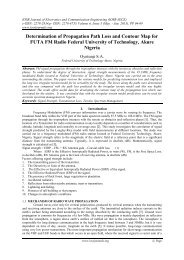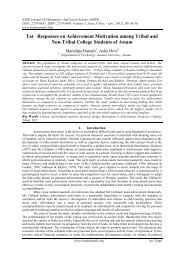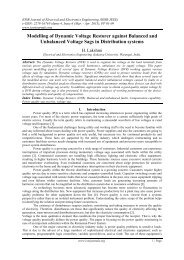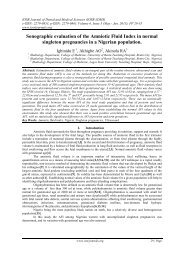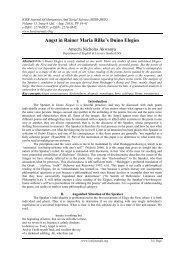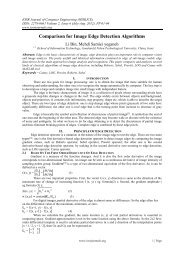<strong>Initial</strong> <strong>Conquest</strong> Of <strong>India</strong> By <strong>Turks</strong> And <strong>Their</strong> <strong>Slaves</strong> 1 Also Aybek, Aybeg, Skt. Shuduvadina, Shutubadina (<strong>India</strong>n Antiquary, xix, p. 186; Epigraphia Indica; Arabic <strong>and</strong> Persian Supplement,Government Press,Delhi(1913-14)(Since 1951 issued as „Arabic-Persian supplement to Epigraphia <strong>India</strong>), p. 43) 1 N.Lees etal (ed.)Tabakat-i-Nasiri, p. 140;M.Hidayat Husaini (ed.) Tarikh-i-Mubarakshahi, p. 14, 16; Ferishta, p. 63. 1 Thomas,Chronicles, p. 34, 37: H.Nelson Wright; The coinage <strong>and</strong> Metrology <strong>of</strong> Sultans <strong>of</strong> Delhi (New Delhi, 1974), p. 69. 1 M.Hidayat Husaini (ed.)Tarikh-i-Mubarakshahi. P. 15;N.Lees etal (ed.)Tabakat-i-Nasiri, p. 140;Ferishta, p. 63;A.M. Husain (ed.)Futuhus-Salatin, vs. 1974-1996. 1 Epigraphia Indo-Moslemica,Govt.Press,Delhi(since 1951 issued as „Arabic <strong>and</strong> Persian supplement to Epigraphia <strong>India</strong>‟) 1911-12, p. 2. 1 N.Lees etal(ed.)Tabakat-i-Nasiri, p. 141;M.Hidayat Husaini (ed.) Tarikh-i-Mubarakshahi, 15; Cf. Mirat-i- Jahan Numa, f. 53, which places his death in 609/1212, whereas Aibak‟s latest inscription is dated Ramzan, 607/1210.(Cf Habibullah Foundation). 1 Raverty, p. 529, note 4; N.Lees etal (ed.)Tabakat-i-Nasiri, p. 141-2; Ferishta, p. 64; Nelson Wright, coinage <strong>and</strong> Metrology, p. 69; Defremery <strong>and</strong> Sanguinetti Ibn Batutah 111, p. 164. 1 N.Lees etal(ed.)Tabakat-i-Nasiri, p. 141-2. 1 Defremery <strong>and</strong> Sanguinetti, Ibn Batautah, III, p. 164. Battuta actually refers to this king as „Lamlish‟. There is a number <strong>of</strong> variant spellings <strong>of</strong> the name, but the proper name appears to have been Iltutmish, „holder <strong>of</strong> the realm (Cf. S. Dig<strong>by</strong>, ‘Iletmish or Iltutmish? A reconsideration <strong>of</strong> the Name <strong>of</strong> the Delhi Sultan’, Iran, 8 (1970), p. 57-64; Thomas Chronicles, p. 43-44,, 71; Nelson wright, coinage <strong>and</strong> Metrology, p. 70). In Sanskrit his name was revealed Lititimisi, or he was referred to as Suritan Sri Samasadin or Samusdina, or simply. The „Turushka lord‟ (Turushkadhipamadaladan) (Z.A. Desai; ‘Inscriptions <strong>of</strong> the Mamluk Sultans <strong>of</strong> Delhi’, in: Z.A. Desai (ed.); Epigraphia Indica, Arabic <strong>and</strong> Persian Supplement (1966) (Delhi, 1967), p. 1-18; „Reference to Muhammadan‟s AD 730-1320 in: The Journal <strong>of</strong> <strong>India</strong>n History, 15 (1936), p. 177. 1 Minhaj, p. 179, where it is included in Iltutmishs conquests, it is called Nardin <strong>by</strong> Utbi,Abu Nasr;Tarikh-i- Yamini,also called Kitab-i-Yamini,Arabic text,ed.Ali <strong>and</strong> Sprenger,Delhi,1847, p. 260: For some years the latter Hindu-Sahiya Kings made it their capital for its location see Raverty: op. cit. p. 534, note i., Imperial Gazetteer <strong>of</strong> <strong>India</strong>, xviii, p. 349; also Nazim,Muhammad; Life <strong>and</strong> Times <strong>of</strong> Sultan Mahmud <strong>of</strong> Ghazna,Cambridge,1931, p. 91. 1 Minhaj, p. 164. 1 Minhaj, p. 174. This date is also, like that on the Daulat Shah Cion, doubtful, for Raverty found 628 in some <strong>of</strong> the older manuscripts, Haji Dabir, ii, p. 698, however, has 627. 1 These places are listed in Iltutmish‟s conquests; Minhaj, p. 179, At Kaman, near Thangir, he built the mosque now known as the Chausat Khamba, See Cunningham; Report, xx, pp. 11 <strong>and</strong> 56. 1 Minhaj, p. 236 1 Minhaj, p. 176, 1 Epigraphia Indica, Arabic <strong>and</strong> Persian Supplement, 1913-14, p. 14-15. 1 Ibid, Epigraphia Indo-Moslemica, 1911-12, p. 3, 27-30; A.M Husain (ed.) Futuhus-Salatin, p. 123-4. 1 Epigraphia Indo-Moslemica, 1911-12, op. cit; p. 27; Z.A. Desai, „Inscription <strong>of</strong> the Mamluk Sultans <strong>of</strong> Delhi‟, Epigraphia Indica: Arabic <strong>and</strong> Persian supplement (1966), ed. Z.A. Desai (Delhi, 1967), (p. 1-18p. 17). 1 There is a rear coin <strong>of</strong> Iltutmish which contains only the name <strong>of</strong> the Caliph <strong>and</strong> which was probably issued to commemorate the arrival <strong>of</strong> the Caliphal diploma <strong>of</strong> investiture (Thomas, Chronicles, p. 46; Nelson wright, Coinage <strong>and</strong> Metrology, p. 18; N.Lees etal (ed.) Tabakat-i-Nasiri, p. 174; Ferishta, p. 66). 1 S. Moosvi;„Numismatic evidence <strong>and</strong> the economic history <strong>of</strong> the Delhi sultanate’, Proceedings <strong>of</strong> the <strong>India</strong>n History congress (1989-90), p. 207-8. 1 Minhaj, p. 176. 1 A.B.M. Habibullah, Foundation <strong>of</strong> Muslim rule in <strong>India</strong>, Allahabad, 1961; p. 105. 1 Minhaj,p.120;Fakhre Mudabbir,p.22. 1 Minhaj,p.139 References [1] Abu Bakr Muhammad Al-Raw<strong>and</strong>i. b.Ali;Rahatus-Sudur ed,M.Iqbal,Cambridge,1922 [2] Al Biruni,Kitab fi Tahqiqi mali-I-Hind (Hyderabad,<strong>India</strong>,1958) [3] Alami.A, Conquetes de Mahmud al- Ghaznawi d‟apres le Kitab al Yamini d‟Utbi,2 vols (Doctorat d‟Etat,Paris,III,1989) [4] Al-Utbi, Tarikh al-Yamini: Persian translation <strong>by</strong> Jurbadqani(1206 AD) (Tehran,1334 H) [5] Al-Utbi,Abu Nasr;Tarikh-i-Yamini,also called Kitab-i-Yamini,Arabic text,ed.Ali <strong>and</strong> Sprenger,Delhi,1847 [6] Al-Utbi,Tarikh al-Yamini (Delhi, 1847) [7] Baizawi,Abu Said Abdullah;Nizamat-Twarikh.Bm.Add.16708.f.51a [8] Bakshi, Nizamuddin; Tabaqat-i-Akbari,(a)ed.De <strong>and</strong> Husain,3 Vols,Calcutta,1927-41.(b)Trans.B.De.3 Vols Cal.1913-40 [9] Bartold;Turkistan down to the Mongol Invasion,Eng. Trans. By H.A.R. Gibb,London,1928,2nd ed.1958 op.cit, p. 333ff www.iosrjournals.org 12 | Page
<strong>Initial</strong> <strong>Conquest</strong> Of <strong>India</strong> By <strong>Turks</strong> And <strong>Their</strong> <strong>Slaves</strong> [10] Beckwith,C.I., „Aspects <strong>of</strong> the Early History <strong>of</strong> the Central Asian Guard Corps in Islam‟,Archivum Eurasia.Medii Aevi,IV(1984), [11] Bosworth,C.E., The Ghaznavids. <strong>Their</strong> Empire in Afghanistan <strong>and</strong> Eastern Iran 994:1040, 2nd edition (Beirut, 1973) [12] Bosworth,C.E.,‟The Imperial Policy <strong>of</strong> the Early Ghaznavids‟,Islamic Studies 1 (1962) [13] Bosworth,C.E.,The Early Islamic History <strong>of</strong> Ghur,Central Asiatic Journal,6 (1961) [14] Bosworth,C.E.,The Later Ghaznavids,Splendour <strong>and</strong> Decay: The Dynasty in Afghanistan <strong>and</strong> Northern <strong>India</strong> 1040-1186 (Eidenburgh,1977). [15] Boyle,J.A., (ed). The Cambridge history <strong>of</strong> Iran, V. The Saljuq <strong>and</strong> Mongol periods (Cambridge, 1968) [16] Buhler,G., The Jagaducharita <strong>of</strong> Sarvanada: a Historical Romance from Gujrat (Vienna,1892), [17] Ch.Pellat et al.(eds.), The Encyclopaedia <strong>of</strong> Islam,new edition (Leiden,1954- in progress). [18] Ch<strong>and</strong> Bardai;Prithviraja Raso,ed.M.V.P<strong>and</strong>ia <strong>and</strong> Sam Sundar Das,Nagari Pracharini Sabha , Benaras,1913 vi: also Raj Darshani, f. 49a. [19] Chattopadhayaya,B.D., „Origin <strong>of</strong> the Rajputs: the political, economic <strong>and</strong> social processes in early medieval Rajasthan‟, IHR 3 (1976), repr.in his The Making <strong>of</strong> early medieval <strong>India</strong> (Oxford <strong>and</strong> Delhi, 1994), 57-88. [20] Chttopadhyaya,D. (ed.); Tarantha‟s History <strong>of</strong> Buddhism in <strong>India</strong> (Calcutta 1980) [21] Clauson,G.,Turkish <strong>and</strong> Mongolian Studies(London,1962) [22] Codrington,K.de.B.,„A Geographical Introduction to the history <strong>of</strong> Central Asia‟,The Geographical Journal,CIV (1944), [23] Dabir Haji;Zafarle-Walihi,edited under the title <strong>of</strong>”An Arabic History <strong>of</strong> Gujrat” <strong>by</strong> E.D.Ross,London,1921 [24] Desai,Z.A., „Inscriptions <strong>of</strong> the Mamluk Sultans <strong>of</strong> Delhi‟, in: Z.A. Desai (ed.); Epigraphia Indica, Arabic <strong>and</strong> Persian Supplement (1966) (Delhi, 1967) [25] Dig<strong>by</strong>,S., „Iletmish or Iltutmish? A reconsideration <strong>of</strong> the Name <strong>of</strong> the Delhi Sultan‟, Iran, 8 (1970) [26] Eaton, M. Richard; Rise <strong>of</strong> Islam <strong>and</strong> the Bengal Frontier,1204-1760,Berkeley <strong>and</strong> Los Angeles,University <strong>of</strong> California Press,1993, [27] Epigraphia Indica, Arabic <strong>and</strong> Persian Supplement,1913-14 (Calcutta, 1917; reprint Delhi, 1987) [28] Epigraphia Indica; Arabic <strong>and</strong> Persian Supplement,Government Press,Delhi(1913-14)(Since 1951 issued as „Arabic-Persian supplement to Epigraphia <strong>India</strong>) [29] Epigraphia Indo-Moslemica,Govt.Press,Delhi(since 1951 issued as „Arabic <strong>and</strong> Persian supplement to Epigraphia <strong>India</strong>‟) 1911-12 [30] Escedy,H.,‟Tribe <strong>and</strong> Tribal Society in the 6th Century Empire‟,Acta Orientalia Hungarica,25 (1972); Golden,P.B., „Imperial Ideology <strong>and</strong> the Sources <strong>of</strong> Political Unity amongst the Pre-Cinggisid Nomads <strong>of</strong> Western Eurasia‟, Archivum Eurasiae Medii Aevi,II (1982) [31] Fakhre Mudabbir(Muhammad b. Mansur b. Said Qurashi);Shajarat (or Bahr) al-Ansab, partial edn. <strong>by</strong> Sir E. Denison Ross;Tarikh [sic]-i-Fakhr al-Din Mubarakshah (London,1927) [32] Ferishta,Qasim b. Hindu Khan;Tarikh-i-Ferishta (Lucknow, 1864) [33] Forbes,A.K.,Rasmala:Hindoo Annals <strong>of</strong> the Province <strong>of</strong> Goozerat in Western <strong>India</strong>,2 vols (London, 1924). (ed. Rawlinson) [34] Gazetteer <strong>of</strong> the province <strong>of</strong> Oudh.3 vols (Lucknow <strong>and</strong> Allahabad,1877-78) [35] Golden,P.B.,An Introduction to the History <strong>of</strong> Turkic Peoples: Ethnogenesis <strong>and</strong> State formation in Medieval <strong>and</strong> Early Modern Eurasia <strong>and</strong> the Middle East (Wiesbaden,1992), [36] Golden,P.B.‟Imperial Ideology <strong>and</strong> the Sources <strong>of</strong> Political Unity amongst the Pre-Cinggisid Nomads <strong>of</strong> Western Eurasia‟,Archivum Eurasiae Medii Aevi.II (1982), [37] Habibullah,A.B.M., Foundation <strong>of</strong> Muslim rule in <strong>India</strong>, Allahabad, 1961 [38] Hall,J.A. <strong>and</strong> Jarvie,I.C. (eds), Transition to Modernity: Essays on Power, Wealth <strong>and</strong> Belief (Cambridge,1992) [39] Hasan Tajud Din Nizami‟s;Taajul-Maathir(The Crown <strong>of</strong> Glorious Deeds),translated <strong>by</strong> Bhagwat Saroop,saud Ahmad Dehlavi,Delhi,1998 [40] Hodivala,S.H.,Studies in Indo-Muslim history (Bombay, 1939-57, 2 vols) [41] H<strong>of</strong>fmann,H.,‟Die Qarluq in der Tibetaischen Literatur‟,Oriens,III,2 (1950), [42] Husain,A.M., (ed). Futuh-us-Salatin <strong>of</strong> Isami (Agra, 1938). [43] Husian,A.M.,(ed); Futuhus-Salatin <strong>of</strong> Isami (Agra, 1938) [44] Ibn Battuta;Kitabur Rahlah,also called,Tuhfatun Nuzzar fi gharaib-il-amsar:ed.(a)Cairo,1870-71, (b)With a French trans.Defremery <strong>and</strong> Sanguinatti,Paris, 4 Vols,1853-59, (c) Abridged Eng. Trans.H.A.R. Gibb,London,1929, (d) Eng.trans.(<strong>of</strong> the travels in <strong>India</strong>,Maldive <strong>and</strong> Ceylon) <strong>by</strong> Mahdi Husain,Baroda,1953, ii [45] Imperial Gazetteer <strong>of</strong> <strong>India</strong>,(Oxford, 1908), [46] Ishwariparasad;History <strong>of</strong> Medieval <strong>India</strong>,Allahabad,1925 [47] Jackson Peter;The Delhi Sultanate,A Political <strong>and</strong> Military History,Cambridge University Press,1999 [48] Journal <strong>of</strong> Asiatic Society <strong>of</strong> Bengal, 1887 [49] Journal <strong>of</strong> Asiatic society <strong>of</strong> Bengal,Calcutta. Old series:in two parts separately for Antiquities <strong>and</strong> Natural Sciences.New series(since 1905): Journal <strong>and</strong> Proceedings.In progress:Journal <strong>of</strong> Royal Asiatic Society <strong>of</strong> Bengal issued separately for Letters,Science <strong>and</strong> Yearbook. (N.S.) [50] Juwaini Alauddin Ata Malik;Tarikh-i-Jahan Gusha-e-Juwaini,ed. Abdul Wahab Qazwini.2 vols.,London,Gibb memorial series,1912-1916.Vol.III a facsimile edition,<strong>by</strong> E.D.Ross,London,1931.Eng trans.J.A.Boyle,2 vols,Manchester,1958 [51] Juzjani, Minhaj,Abu Umar b. Siraj;Tabaqat-i-Nasiri,(a) ed.Nasau Lees,Khadim Hussain,<strong>and</strong> Abdul Hai Bib.Ind.Calcutta,1864.(b)English trans.By H.G.Raverty,2 Vols,Bib.Ind Calcutta,1897 [52] Kirtane, N. Janardan,„The Hammira Mahakavya <strong>of</strong> Nagach<strong>and</strong>ra Suri‟, <strong>India</strong>n Antiquary (1890) [53] Kwanten,L., Imperial Nomads: a History <strong>of</strong> Central Asia,500-1500(Philadelphia,1979) [54] Mahmood,.T.,`The Dargah <strong>of</strong> Sayyid Salar Masud Ghazi in Bahraich:Legend,Tradition <strong>and</strong> Reality‟,in: Ch. Troll (ed.),Muslim Shrines in <strong>India</strong> (New Delhi,1984). [55] Maricq,A. <strong>and</strong> Weit,G., Le minaret de Djam. La decouverte de la capitale des sultans Ghorides (XII-XIII siecles) (paris, 1959) [56] Mc Gregor,R.S., Hindi Literature from its Beginnings to the Nineteenth Century (Wiesbaden, 1984) [57] Mirat-i-Jahan Numa,B.M.Or.1998 f. 50a [58] Morley,W.H., (ed.),Tarikh-i-Baihaqi (Calcutta,1862) [59] Mubarakshah, Fakhruddin,(Known as Fakhre Mudabbir);Tarikh-i-Fakhruddin Mubarakshah,ed.E.D.Ross,London,1867, p. 22). [60] Munshi Hiraman, Gwalior Namah.B.M.Add. 16709. [61] N. Lees etal.; (eds) Tabaqat-i-Nasiri <strong>of</strong> Abu Umar al-Juzjani (Calcutta, 1894) [62] Narain,A.K., The Indo-Greeks (Delhi,1980), [63] Nazim,Muhammad; Life <strong>and</strong> Times <strong>of</strong> Sultan Mahmud <strong>of</strong> Ghazna,Cambridge,1931 [64] Nazim.M., (ed.),Zayn al-Akhbar <strong>of</strong> Gardizi (Berlin,1928), www.iosrjournals.org 13 | Page



